Fresco boards and tiles with their development history,
Making Fresco Panels
Tile #6, 3-17-4, Skim milk painted on tile, rough thin layer of large sand and lime, 2:1.
4-1-4,
6:00 PM, soak tile for 3 hours, add alum to small crushed limestone 1:1 lime. A 2.5 inch square of mortar covers 12 square inches of mural, it took a hour and a half to lay it down.
7:30, intonaco finished.
9:00 PM, still too wet, perhaps I'll try something I've read about but never had any conformation on, paint on it the next day after washing off the crust and adding limewater before painting.
4-2-4,
10:20 AM. It's hard to believe what has happened. I re-soaked the tile for two minutes, wiped the surface with a soft sea sponge under water, and the calcium carbonate crust came off in flakes! Amazing! Fresco dries from the top down and the dry top is removable.
I have it out of the water right now, absorbing the surface water. A couple of coats of lime water were painted on and soaked in and it's ready to paint on. The surface is harder then I'm used to having to paint on. I'm very excited. Nowhere that I've read has explained this phenomenon. It's taking fresco to a new level, along with Indian yellow synthetic, Quinacridone red, Thalo green and quinacridone magenta. Thalo blue already had the green light but no one suggested grinding and storing it in alcohol and letting the alcohol dry out on the palette before adding limewater. Indian yellow is the only synthetic color I store in water. No one has suggested adding a little industrial strength ammonia to all the earth colors to keep them from forming mold inside the wet storage jars either. The ammonia gas escapes when it can and only the water is left behind.
10:40, Now that water has soaked in I can see the shiny spots around the edges where I didn't get the crust off. I'm re-soaking it again. The intonaco is more fragile in this second soaking, be careful. When this water soaks in I'm painting on a coat of lime milk #5, made from cream.
TIP: Lime Milk #1 is as fluid as milk, milk to the consistency just before it will hold a peak is Lime Milk #5, this is what I add to pigments. Lime Cream will hold a round peak, Lime Putty will form a solid shape.
2:00, it's ready to paint.
Pink Anthurium and Red Vase
3:13, painting very well. I'm keeping it wet down because I'm multi-tasking and haven't gotten very far. Right now I'm thinking "this the way to do fresco".
4:10, this is painting so nicely, I get to take lunch breaks, cigarette breaks, It's still absorbing perfectly. Colors that have sunk in aren't moving when I put lime washes over them. It's been over 21 hours since I applied the intonaco.
5:40, I'm still pushing, pulling and adding colors all over the fresco. This is the most fun I have had on a fresco and the only way from now on. This is also my best fresco yet as far as technique is concerned.
6:35, finished. It could have gone a lot longer. Six and a half hours painting, twenty four and a half hours after laying the intonaco.
The colors used were: Titanium white, Venetian White Earth, Naples yellow, light gold ocher, cobalt blue light, Thioindigoid red, Thalo blue, quinacridone magenta.
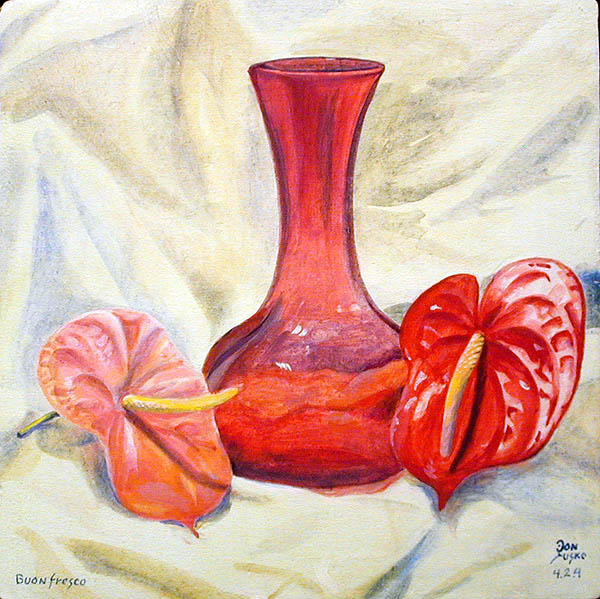
Tile #5, Skim milk painted on tile, thin layer of loose lime 1:1 large sand.
8:00 PM, 4-3-4, finished 3/32nd intonaco layer of 1:1 lime and small crushed limestone, alum added. That's 1/32 less then 1/8". I set the tile on wet newspapers for the night.
4:30 PM, 4-4-4, I washed off the crust a little differently on this Tile #5 then on #6. Tile # 6 I let soak and the crust flaked off but the intonaco got softer. Today's Tile #5 I started with the sponge as soon as I got it under water, very lightly I sponged off that top layer of lime that forms when toweling a smooth intonaco. It came off on Tile # 6 also, along with the crust. I will paint on another layer of lime cream on the horizontal surface and let it soak in. It's probably not necessary but I like the smoother surface. Be sure you wash off all the loose sand, you won't get another chance to brush it off dry.
Green on Green #1
I went shopping for subject matter this morning after dreaming of a green fresco. I'm going to get to test all my green pigments. Thalo green is the toughest on to work with, I have to keep the pigment wet or it hardens like Pozzuoli red, quinacridone magenta, titanium white and Thalo blue. Thalo green is hard to grind in water, even after solidifying it in alcohol, it has to be forced to be ground in water. No Problem.
On my next fresco I want to figure a way to just remove the crust and leave the lime surface be.
6:30, ready. Drawing with green earth, shot photo to show drawing and surface texture. I't much rougher the my other frescos. After drawing a painted on two coats of lime water and took a brake.
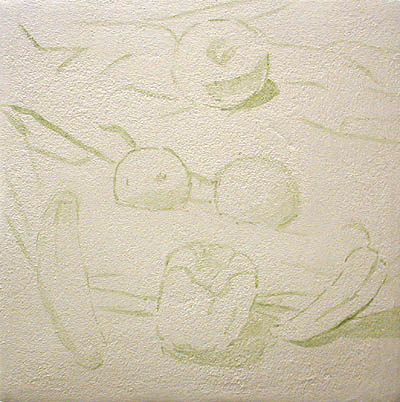
6:45, I painted it a solid color background with Thalo green, lime paste and titanium white. Now I'll paint it the background shadows.
7:20, the background is finished. Thalo green, quinacridone magenta, Thalo blue and chromium green oxide, titanium white and lime white.
Because of my friend Steve Ladd's suggestion for using bristle brushes, Steve is making an ultramarine blue in lime paste test right now, and the fact that this new technique has a harder intonaco because it has set for 24 hours.. I'm painting this fresco using synthetic bristle brushes. they are working just fine.
I wet the fruit with lime water and am taking a 5 minute break.
8:20, the top three fruits are finished, I wet down the bottom 3 and am taking another break.
9:30, finished, the synthetic bristle brushes worked great, the rough surface was a relief and I enjoy it. The colors used were: Thalo green, quinacridone magenta, Thalo blue and chromium green oxide, cobalt blue light, light gold ocher, titanium white and lime white. 100% of the fresco contained Thalo green.
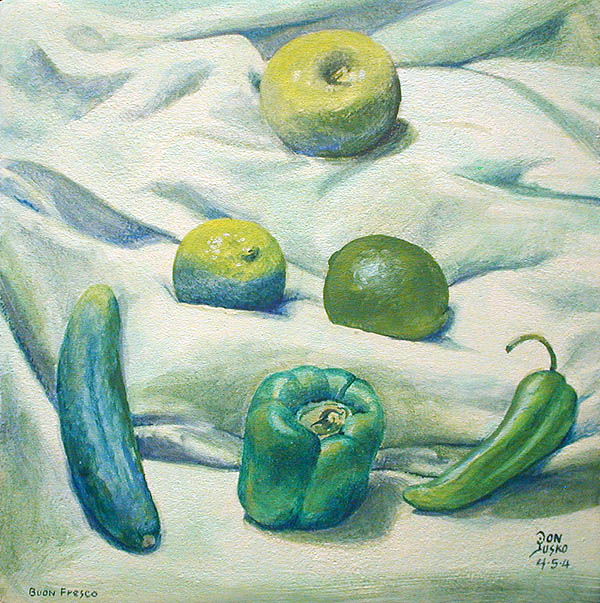
Board Z1, 02-24-08, Z1=12x12, alum, large sand, glue binder, 1x1, 3-24-4, sanded the back to the board, they were buckling when just the front got water. Soaked the board, painted on casein, and laid on a large and small sand thin rough with casein added. READY for intonaco.
Board Z1, 4-5-4, 2:00 PM, finished intonaco with 3/32", 1:1 lime and crushed limestone, alum added.
Board Z1, 4-7-4, 5:00 PM. Fifty hours after laying the intonaco, having covered it in plastic and wet newspapers, I sponged off the top crust. This is a big step forward, controlling the drying time and removing the crust. The mortar was hard enough to be able to just remove the calcium carbonate and the top layer of lime. It's still a smooth surface. When all the water had absorbed, I painted a coat of lime cream.
Yellow Fruit and Veggies
Yellow and blue are complements.
6:40, the drawing is finished and the back has a fairly even layer of color. It's absorbing well.
9:30, finished, it's still absorbing paint well. Four and a half hours. The colors used were; titanium white, Naples yellow, cadmium yellow, gold yellow ocher, Indian yellow, cadmium orange, thalo blue, ultramarine blue, cadmium red, burnt umber.
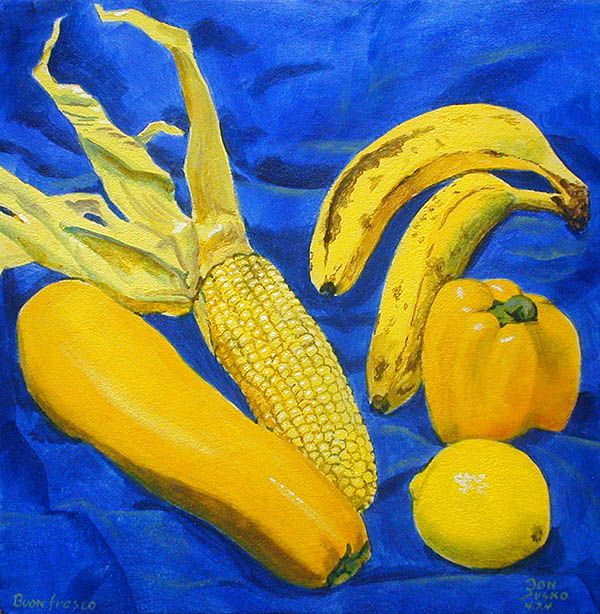
The next morning the fresco had a nice healthy carbonate sheen all over it. Any color with ultramarine blue in it has to be an early color down. The same for magenta and Thioindigoid red. This technique of removing the first forming crust before painting seems to be the best fresco method. If you don't have that sheen by the second day, colors are just laying on top.
Board D1, 02-26-04, D1= 12x12, alum, glue binder, 1 limestone crushed and sifted for the larger grit, 1 medium #1-20 sand, 1 lime, 1:2.
Board D1, 4-9-4, 10 AM, twenty hours after laying intonaco. This time I removed the top lime coat delicately with my fingers, to have a smoother surface to paint on.
Green Mangos on Magenta
10:30, painting, draw with yellow golden ocher,
11:05, drawing finished.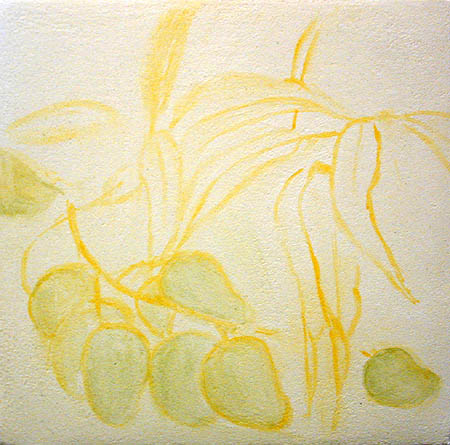
11:45, I learned something yesterday while going over the blue pigment and absorption tests. Now every color I put down has a little lime paste in it, starting with the drawing. The trick is to add lime, if you don't you're going backwards. Now that
I'm adding lime cream I have a new tool on the table, my spray bottle.
12:00, second photo, starting to add cool colors, with lime in it..
1:15, background finished.
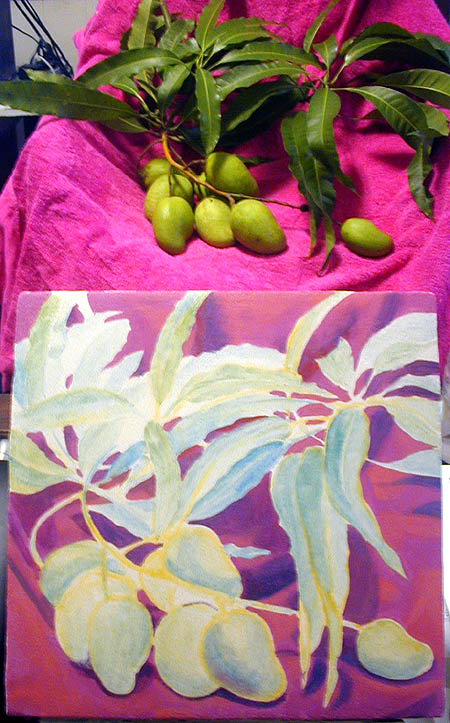
4:30, every spot of paint has lime cream in it. I laid it down and sprayed it with water, nothing bled. I still have to fill in the holidays.
5:30, Finished, now wash out the lime in the brushes with vinegar, then soap and water, then conditioner. I can't wait to see any color changes since I added lime cream to every stroke.
The colors used were, titanium white, quinacridone magenta, Thioindigoid red, golden yellow oxide, Naples yellow, Thalo green, viridian, ultramarine blue, Thalo blue, green oxide and green earth.
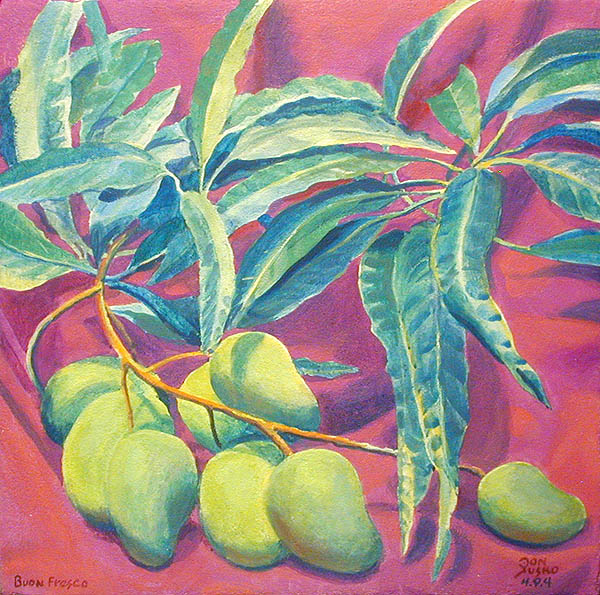
Basket of Pink Flowers #1
Board K. 02-29-04 K= 12x12, glue on board, glue in mortar, large sand and small sand, 1:2. New rough, casein on old rough, casein in mortar with large sand. Back sanded. READY
4-8-4, 3:38, 1:1 lime and small crushed limestone.
4-10-4, 4:00, It's been setting with the intonaco finished and wet for more the 24 hours. I just washed off the calcium carbonate crust and painted on some new lime cream. The crust keeps it from drying too fast.
5:00 sprayed with lime water.
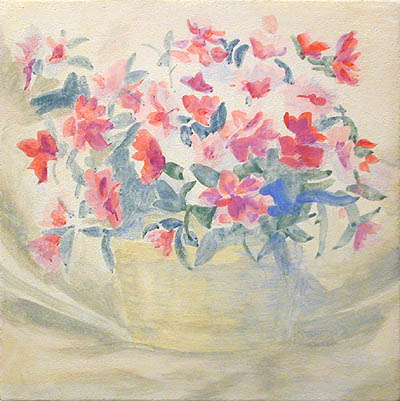
6:05, sprayed again, I'm adding 20% titanium white to lime cream to mix with all my colors.
7:40, spray, I'm getting close to the end. Add some definition to the flowers.
8:47, Finished. Lime cream added to every stroke. The colors for this painting were: titanium white, Naples yellow, Venetian white earth, raw sienna, Thioindigoid red, quinacridone magenta, Viridian.
4-12-4, Adding lime to every stroke remove my contrasts.
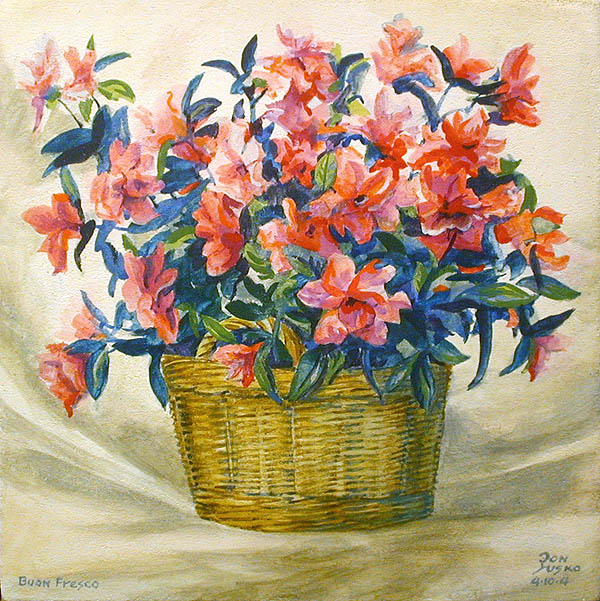
Basket of Pink Flowers #2
Thin Tile #1, Intonaco yesterday at 3:00, I left it uncovered until today.
4-12-4, 5:00 It was too hard, perfect, but too hard. I soaked the whole tile and took off the top layer and it left it really rough. Too rough for me. I should have just let it soak until the crust separated.
5:30 -7:00, added another layer of 1:1 intonaco with alum. I could have just covered the top with pastic seran wrap yesterday, then I would be painting now..
This is the fresco I am going to test with acrylic as the medium instead of limewater.
9:00, too wet to work on.
9:20, It happened fast, already a crust was forming that beaded water. It took a lot of strokes with limewater to break it down. I'm ready to start.
1:15, finished. This work is all about contrast and using an acrylic concrete sealer as a medium in lime. It painted well, absorbed normally and kept bright colors. The first color down was ultramarine blue, it never lost it's brilliance, nor did any other color. The background is ultramarine blue with vine black shadows. Right now the mortar is still wet enough to move with a finger's touch. The acrylic sealer is still wet right along with it. The white signature went over the blue with ease. I expect it to dry normally also.
The colors used in this fresco were; ultramarine blue, vine black, quinacridone red, cadmium orange, green oxide, yellow oxide, raw sienna and Naples yellow.
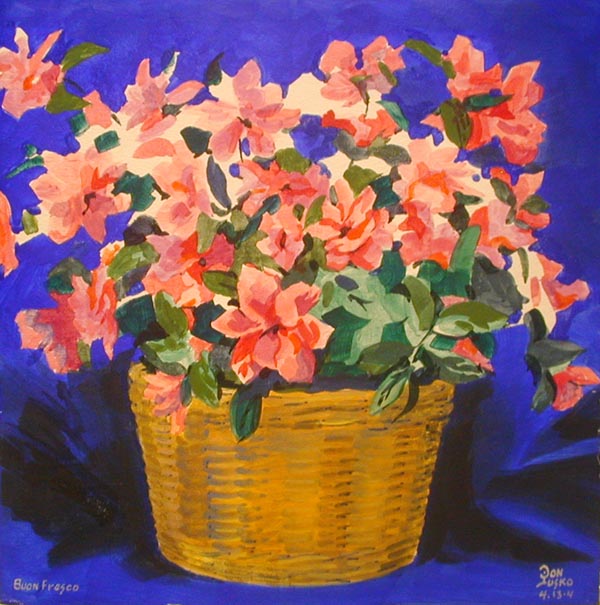
|










